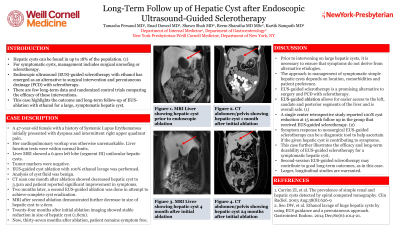Back


Poster Session E - Tuesday Afternoon
Category: Interventional Endoscopy
E0463 - Long-Term Follow-Up of Hepatic Cyst After Endoscopic Ultrasound-Guided Sclerotherapy
Tuesday, October 25, 2022
3:00 PM – 5:00 PM ET
Location: Crown Ballroom

Has Audio

Tamasha Persaud, MD
New York Presbyterian-Weil Cornell Medical Center
New York, NY
Presenting Author(s)
Tamasha Persaud, MD1, Kartik Sampath, MD2
1New York Presbyterian-Weil Cornell Medical Center, New York, NY; 2New York-Presbyterian Hospital/Weill Cornell Medicine, New York, NY
Introduction: Hepatic cysts can be found in up to 18% of the population. (1) In most cases they are benign, asymptomatic and do not require any intervention. For symptomatic cysts, management includes surgical unroofing or sclerotherapy. Endoscopic ultrasound (EUS)-guided sclerotherapy with ethanol has emerged as an alternative to surgical intervention and percutaneous drainage (PCD) with sclerotherapy. There is few long-term data and randomized control trials comparing the efficacy of these interventions. This case highlights the outcome of EUS-ablation with ethanol for hepatic cyst after long-term follow up.
Case Description/Methods: Patient is a 47-year-old female with a history of Systemic Lupus Erythematous who initially presented with dyspnea and intermittent right upper quadrant pain then found to a large hepatic cyst on echocardiogram. Her cardiopulmonary workup was otherwise unremarkable. Liver function tests were within normal limits. She underwent liver MRI which showed a 6.9cm left lobe (segment III) unilocular hepatic cysts. Tumor markers were negative. She was referred to GI and EUS-guided cyst ablation with ethanol was performed. Analysis of cyst fluid was benign. CT 1 month after ablation showed decreased hepatic cyst to 3.5cm and patient reported significant improvement in symptoms. Two months later, a second EUS-guided ablation was done in attempt to achieve complete cyst eradication. MRI after second ablation demonstrated further decrease in size of hepatic cyst to 2.6cm. Seventeen months after initial ablation imaging showed stable reduction in size of hepatic cyst (1.8cm).
Discussion: Prior to interventions for simple hepatic cysts, it is necessary to ensure that symptoms are not from alternative etiologies. The approach to management of symptomatic simple hepatic cysts depends on location, comorbidities and patient preference. EUS-guided sclerotherapy is a promising alternative to surgery and PCD with sclerotherapy. A single center retrospective study reported 100% cyst reduction at 15 month follow up in the group that received EUS guided sclerotherapy. EUS-guided ablation allows for easier access to the left, caudate and posterior segments of the liver compared to PCD and is overall safe. (2)
1. Carrim ZI, et al.The prevalence of simple renal and hepatic cysts detected by spiral computed tomography. Clin Radiol. 2003 Aug;58(8):626-9
2. Seo DW, et al. Ethanol lavage of huge hepatic cysts by using EUS guidance and a percutaneous approach. Gastrointest Endosc. 2014 Dec;80(6):1014-21.
Disclosures:
Tamasha Persaud, MD1, Kartik Sampath, MD2. E0463 - Long-Term Follow-Up of Hepatic Cyst After Endoscopic Ultrasound-Guided Sclerotherapy, ACG 2022 Annual Scientific Meeting Abstracts. Charlotte, NC: American College of Gastroenterology.
1New York Presbyterian-Weil Cornell Medical Center, New York, NY; 2New York-Presbyterian Hospital/Weill Cornell Medicine, New York, NY
Introduction: Hepatic cysts can be found in up to 18% of the population. (1) In most cases they are benign, asymptomatic and do not require any intervention. For symptomatic cysts, management includes surgical unroofing or sclerotherapy. Endoscopic ultrasound (EUS)-guided sclerotherapy with ethanol has emerged as an alternative to surgical intervention and percutaneous drainage (PCD) with sclerotherapy. There is few long-term data and randomized control trials comparing the efficacy of these interventions. This case highlights the outcome of EUS-ablation with ethanol for hepatic cyst after long-term follow up.
Case Description/Methods: Patient is a 47-year-old female with a history of Systemic Lupus Erythematous who initially presented with dyspnea and intermittent right upper quadrant pain then found to a large hepatic cyst on echocardiogram. Her cardiopulmonary workup was otherwise unremarkable. Liver function tests were within normal limits. She underwent liver MRI which showed a 6.9cm left lobe (segment III) unilocular hepatic cysts. Tumor markers were negative. She was referred to GI and EUS-guided cyst ablation with ethanol was performed. Analysis of cyst fluid was benign. CT 1 month after ablation showed decreased hepatic cyst to 3.5cm and patient reported significant improvement in symptoms. Two months later, a second EUS-guided ablation was done in attempt to achieve complete cyst eradication. MRI after second ablation demonstrated further decrease in size of hepatic cyst to 2.6cm. Seventeen months after initial ablation imaging showed stable reduction in size of hepatic cyst (1.8cm).
Discussion: Prior to interventions for simple hepatic cysts, it is necessary to ensure that symptoms are not from alternative etiologies. The approach to management of symptomatic simple hepatic cysts depends on location, comorbidities and patient preference. EUS-guided sclerotherapy is a promising alternative to surgery and PCD with sclerotherapy. A single center retrospective study reported 100% cyst reduction at 15 month follow up in the group that received EUS guided sclerotherapy. EUS-guided ablation allows for easier access to the left, caudate and posterior segments of the liver compared to PCD and is overall safe. (2)
1. Carrim ZI, et al.The prevalence of simple renal and hepatic cysts detected by spiral computed tomography. Clin Radiol. 2003 Aug;58(8):626-9
2. Seo DW, et al. Ethanol lavage of huge hepatic cysts by using EUS guidance and a percutaneous approach. Gastrointest Endosc. 2014 Dec;80(6):1014-21.
Disclosures:
Tamasha Persaud indicated no relevant financial relationships.
Kartik Sampath indicated no relevant financial relationships.
Tamasha Persaud, MD1, Kartik Sampath, MD2. E0463 - Long-Term Follow-Up of Hepatic Cyst After Endoscopic Ultrasound-Guided Sclerotherapy, ACG 2022 Annual Scientific Meeting Abstracts. Charlotte, NC: American College of Gastroenterology.

